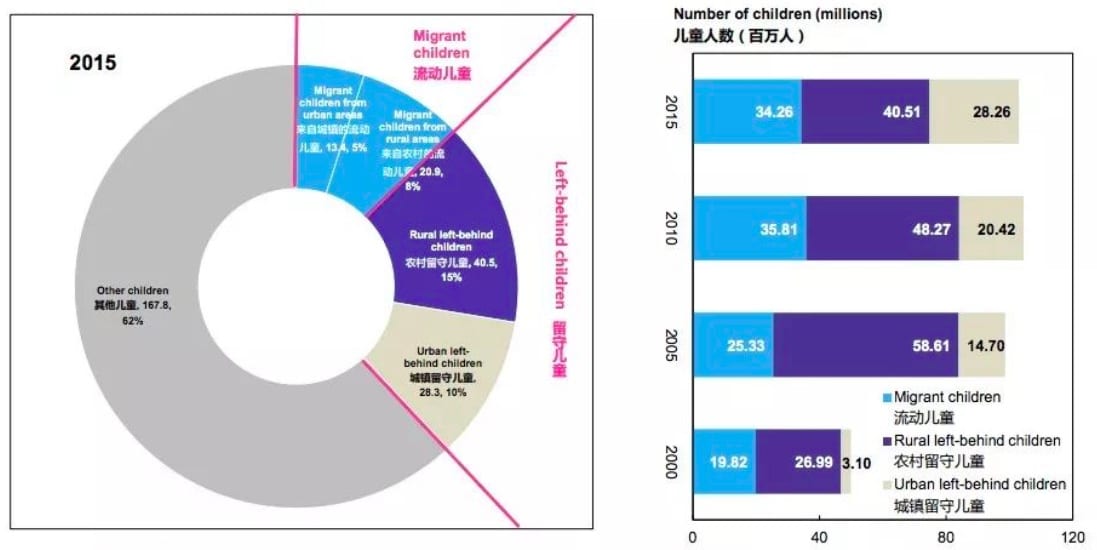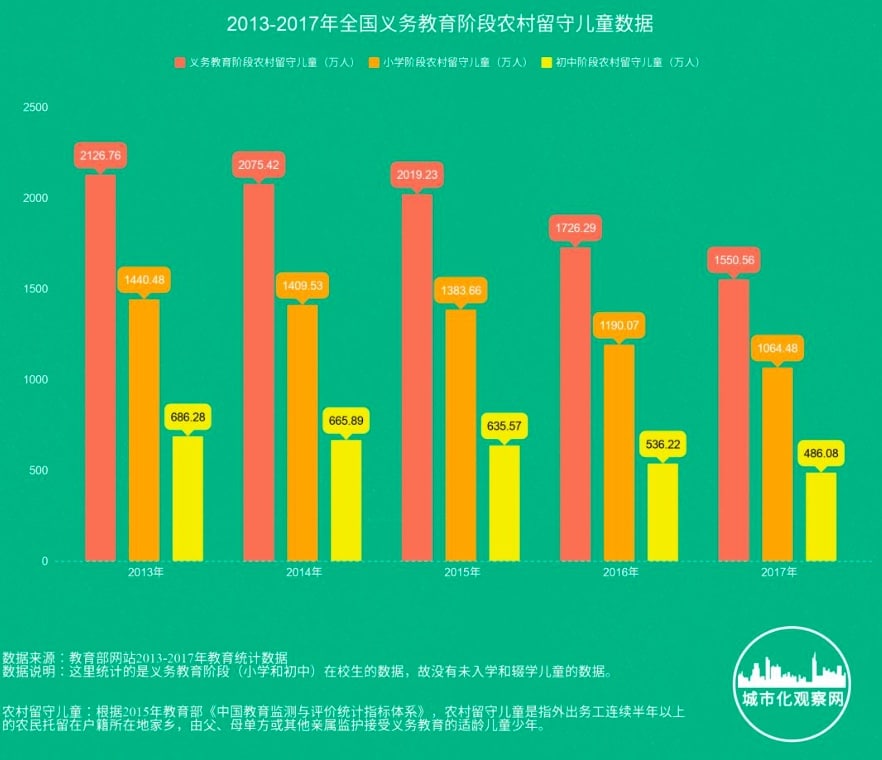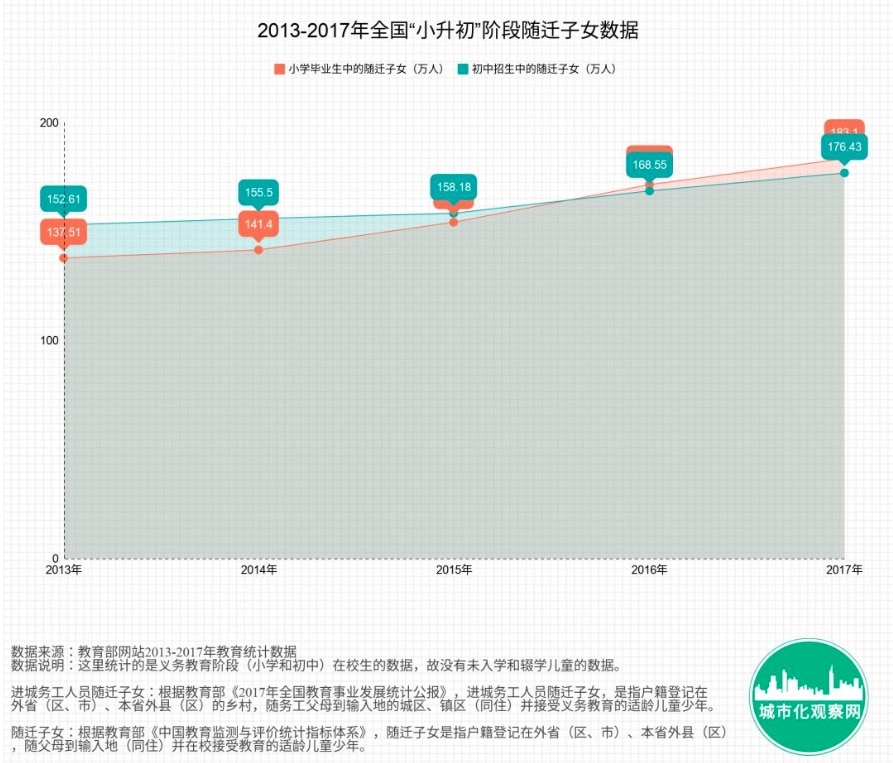Editor’s Note
This article was originally published by Cityobserve (城市化观察网) on the 16th of August 2018. Below is CDB’s translation. The article makes use of the term 随迁子女, which we have translated as “taken-along children”, rather than the more commonly used but less accurate 流动儿童, or “migrant children”.
How many migrant or left-behind children are there in China? This is not a question that can be easily answered.
Generally it can be said that there are 100 million children affected by migration in China. This number comes from the 2015 report by UNICEF (Population status of Children in China in 2015: Facts and Figures). But this figure was calculated from a survey of 1% of the population in 2015 and from the 2010 national census data.
Are there more accurate figures? In order to find them, the data must be limited to the years of compulsory education – the Ministry of Education can use schooling statuses to accurately calculate the situation of migrant and left-behind children enrolled in schools. Of course this data will also have limitations, as it will not include children that are not enrolled in school or students who have dropped out; furthermore this data will not include children in senior secondary education.
Cityobserve used data from the Ministry of Education’s 2017 education data, published in August 2018, to calculate that in 2017 the number of “taken-along children” (随迁子女) and rural left-behind children in compulsory education was respectively 18.9745 million and 15.5056 million, 34.48 million in total. Over the past five years the number of taken-along children in compulsory education has increased by 2.8386 million, and the number of rural left-behind children has decreased by 5.762 million.

Graphs displaying the distribution of different categories of children across the population from 2000-2015
1. Data for “Taken-Along Children”
In 2017, the number of taken-along children enrolled in compulsory education was 18.9745 million children, increasing by 2.8386 million over the past five years, a 17.6% increase. This includes 14.0663 million children taken by migrant worker parents into cities, a figure which increased by 1.2947, or 10.14%, over the past five years.
In the last five years, the general number of taken-along children has increased faster than the number of taken-along children of migrant workers, indicating that the populations moving between cities is increasing faster (of course this may also be to do with “in situ urbanisation” – please see point 3 for further analysis).
The media uses the term “migrant children” (流动儿童), but this is not the term utilised by the Ministry of Education.
In general “migrant children” refers to “ taken-along children” (随迁子女), but the term must be used in context and has to be split into two concepts: “taken-along children” and “taken-along children of migrant workers” (进城务工人员随迁子女). Put simply, the former includes the latter.
Taken-along Children: according to the Ministry of Education, taken-along children refers to children and adolescents living with their parents and going to school in the same place, but registered outside of the province or outside of the county. (moving from rural to rural or urban to urban areas)
Taken-along Children of Migrant Workers: according to the Ministry of Educations 2017 data, taken-along children of migrant workers refers to children and adolescents living with their parents who work as labourers and going to school in the same place, but registered in a rural village in a different province or county. (moving from rural areas to the city)
a) Primary education
In 2017 the number of taken-along children at the stage of primary education was 14.052 million children, increasing by 2.1839 million over the past five years. In 2017 the number of taken-along children of migrant workers was 10.4216 million, increasing 1.1133 million over the past five years.
b) Junior secondary education
In 2017 the number of taken-along children in junior secondary education was 49.225 million children, increasing by 6.547 million over the past five years. The number of taken-along children of migrant workers was 36.445 million children, increasing by 1.814 million over the past five years.
2. Data for Rural Left-Behind Children
As with “taken-along children” and “taken-along children of migrant workers”, there are also differences between “left-behind children”, “rural left-behind children” and “urban left-behind children”. According to the 2015 UNICEF report, in 2015 there were over 28 million urban left-behind children under 17 years old. Unfortunately the Ministry of Education did not have data on urban left-behind children, so we can only use data regarding rural left-behind children.
The definition of Rural Left-Behind Children: according to the Ministry of Education, rural left-behind children refers to children and adolescents in education who are registered in their place of origin but whose parents are rural migrant workers who have left home for over six months, and they live with only one parent or with other relatives.

Graph displaying the enrolment of rural left-behind children in compulsory education. Total rural left-behind children enrolled in compulsory education (red), rural left-behind children enrolled in primary school (orange), rural left-behind children enrolled in junior secondary education (yellow).
From the graph above it can be seen that over the past five years the number of rural left-behind children enrolled in compulsory education has decreased by 5.762 million, a 27% decline.
Considering that the number of children under 14 years of age has been continually increasing between 2013 and 2016, could it be possible that the number of rural left-behind children not enrolled in school or dropping out of school has increased? This does not seem possible. From recent statistics the rate of enrolment of children in primary school is 99.9%, the gross enrolment rate for junior secondary school is 104% and the completion of nine years of compulsory education is over 93%.
In order to investigate the puzzle of the decreased number of rural left-behind children, the data for urban left-behind children and taken-along children of migrant workers need to be considered too.
3. Why has the number of rural left-behind children decreased so dramatically?
In 2013 the number of rural left-behind children was 8.496 million higher than the number of taken-along children of migrant workers, but in 2017 the difference was only 1.4393 million. There are at least three reasons for this:
a) The fact that the new generation of migrants is more inclined to take their children with them is one huge factor behind the decrease of rural left-behind children. China’s 2016 national migrant population development report shows that nearly 90% of the new generation of migrants move with their partners, and 60% move with their children. In other words, the increase of taken-along children of migrant workers can account for the decrease of rural left-behind children, to a certain extent.
b) Migrants are acquiring local residency. According to statistics from the State Council, most cities have relaxed requirements for local residency registration, stimulating a rise in rural to city residency transfers. More and more migrants are going through the procedure to gain a local hukou for themselves and also for their children. Therefore their children will no longer be counted as “taken-along children” or “left-behind children”.
c) “In situ urbanisation” has decreased the number of rural left-behind children, but has increased the number of urban left-behind children. This factor is mentioned in the 2015 UNICEF report, stating that between 2010-2015 the number of urban left behind children under 17 years of age has increased from 20.42 million to 28.26 million. “In situ urbanisation” refers to some areas that were originally rural administrative regions turning into “combined” administrative areas. However, this kind of urbanisation will not bring back migrant populations for work or entrepreneurship, so although the registration status of the local people has changed from rural to urban, the vast majority of the working population will still find work elsewhere. Therefore, although the children have gone from being rural left-behind children to urban left-behind, their situation is still much the same.
4. What is the educational enrolment situation of taken-along children?
Although the situation of taken-along children is much better than that of left-behind children, due to the current registration system they still face many obstacles in their education.
a) The rate of enrolment in state education is lingering
The proportion of left-behind children enrolled in state education increased considerably 2011. The former Minister for Education Yuan Guiren revealed that in 2011 the rate of enrolment in education of taken-along children of migrant workers was around 79.2%, a 12.7% increase from 2010. However, between 2011 and 2016 the proportion of taken-along children of migrant workers enrolled in education continued to hover around 80%.
b) A large number of migrant children return home when progressing from primary to junior secondary education
In 2016 and 2017, the number of taken-along children registering and entering junior secondary education was lower than the number graduating from primary education (see the red area in the graph below). There could be two possible reasons for this: one is the “fight for population” between cities resulting in lower thresholds for residency, meaning that while the children were in primary school their parents could have gained local residency. The other issue is that a large number of taken-along children are forced to return to rural areas as their grades are not high enough to be enrolled in urban schools with higher entry requirements, and a large number of those will become left-behind children.

Graph displaying national 2013-2017 data on taken-along children in transition between primary and secondary school. Number of primary school graduates who are taken-along children (orange), number of newly enrolled junior secondary school students who are taken-along children (blue).
China is still in the process of rapid urbanisation, and the relative numbers of taken-along children is in a stage of rapid increase. To make it easier for taken-along children to enrol in school there needs to be work done in two aspects:
Firstly, the requirements of urban residency registration need to continue to be relaxed, following the “Notice of the State Council on promoting the settlement of 100 million non-registered urban people”. Although many migrant city dwellers have gained residency, the vast majority of cities have restrictions on the number of registrations. For example in Guangzhou in 2018 the limit was set at 7000, and in Qingdao and Wuhan at 2000. Cityobserve has outlined the residency policies of 15 cities, for more details click here.
Secondly, the resources for compulsory education need to be allocated with consideration of all long-term residents, and not only those who are registered. This requires the government of the areas that take in migrants to consider outsiders who live in the area long-term when planning and allocating funding. Recently, the website of the Ministry of Education published a notice on national education, document 27, which states the newest “List of contents for evaluation and recognition of primary and junior education in counties (cities and districts)”. The most important point is that this is the fist time the State Council publishes a policy that specifically flags the educational enrolment of taken-along children: “Children and adolescents of school age should enjoy equal opportunity to education. The proportion of eligible taken-along children enrolled in state or state-owned schools cannot drop below 85%”.



